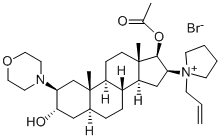Propargyl bromide , 98%, containing 0.3%MGO stabilizer , 106-96-7
Synonym(s):
3-Bromo-1-propyne
CAS NO.:106-96-7
Empirical Formula: C3H3Br
Molecular Weight: 118.96
MDL number: MFCD00000241
EINECS: 203-447-1
PRODUCT Properties
| Melting point: | -61°C |
| Boiling point: | 97 °C |
| Density | 1.38 g/mL at 20 °C |
| refractive index | n |
| Flash point: | 65 °F |
| storage temp. | 2-8°C |
| solubility | Chloroform, Methanol (Slightly) |
| form | Liquid |
| color | Colorless - Yellow |
| Water Solubility | Miscible with ethanol, ether, benzene, carbon tetrachloride and chloroform. Immiscible with water. |
| Sensitive | Light Sensitive |
| BRN | 605309 |
| Exposure limits | ACGIH: TWA 20 ppm OSHA: Ceiling 300 ppm; TWA 200 ppm NIOSH: IDLH 500 ppm; TWA 100 ppm(375 mg/m3); STEL 150 ppm(560 mg/m3) |
| InChIKey | YORCIIVHUBAYBQ-UHFFFAOYSA-N |
| CAS DataBase Reference | 106-96-7(CAS DataBase Reference) |
| NIST Chemistry Reference | 1-Propyne, 3-bromo-(106-96-7) |
| EPA Substance Registry System | Propargyl bromide (106-96-7) |
Description and Uses
Propargyl bromide is a Shock sensitive liquid, lachrymator. Supplied as an 80% solution in toluene stabilized with magnesium oxide. Alternative formulations are currently under development.
Propargyl bromide, 80% in toluene is used to prepare betulonic acid-peptide conjugates with anti-inflammatory activity and propargylic amines employed in enyne metathesis. It finds application in the propargylation of spiro ketones, allylic alcohols and enone complexes. In Barbier-type reaction, it reacts with aldehydes to give alkyne alcohols. It is actively involved in the synthesis of polyethylene glycol (PEG) and peptide-grafted polyesters.
Safety
| Symbol(GHS) |     GHS02,GHS05,GHS06,GHS08 |
| Signal word | Danger |
| Hazard statements | H225-H301-H304-H314-H335-H373 |
| Precautionary statements | P210-P280-P301+P330+P331-P303+P361+P353-P304+P340+P310-P305+P351+P338 |
| Hazard Codes | F,T,C |
| Risk Statements | 60-61-20/21-25-63-36/37/38-11-67-65-48/20 |
| Safety Statements | 53-16-36/37/39-45-37/39-28A-26-62-36/37 |
| RIDADR | UN 2345 3/PG 2 |
| WGK Germany | 3 |
| RTECS | UK4375000 |
| F | 8 |
| Hazard Note | Highly Flammable/Toxic/Corrosive |
| TSCA | Yes |
| HazardClass | 3 |
| PackingGroup | II |
| HS Code | 29033990 |
| Hazardous Substances Data | 106-96-7(Hazardous Substances Data) |






